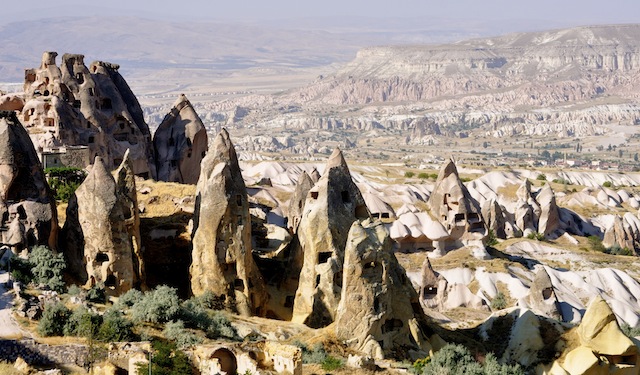By Anna Frisk
In Argentina, I hopped between vineyards on bike. In Australia, it was in a car. In Turkey, I can now tell you, it was on foot.
In queue for a flight to Istanbul, another passenger approached me. “Are you going to Turkey, too?” It seemed highly obvious, but I took the welcome distraction with a smile. Yes. I told him about my travel plans, most excitedly about the four days I’d spend in sun-drenched Cappadocia, where I already envisioned my itinerary packed full. As my guidebook hinted, I’d be discovering a honeycomb landscape dotted with fairy chimneys and ancient cave churches. With scores of valleys to discover, on foot and floating in the air (aboard an atmospheric hot air balloon), I didn’t expect more from Turkey’s interior.

With one short sentence, he altered my perception of Cappadocia. “They have good wine there.” He was Turkish, his name Murat, and as the words sunk in I could already envision my plans shift. Wine?
In Spain, my previous home of two years, I planned whole trips around it. I got giddy at the idea of wine tasting in a picturesque valley, or uncorking a rare find with friends. Wine tasting on a lunar-like-landscape? Before boarding the plane, I scribbled the note, “must research Turkish wine.”
To quell any misconceptions, many Turks drink. The country is Muslim in definition and spirit, but the line is a softer one. They even have a national drink: an anis-laced alcohol called raki. As I quickly learned, many take a liberal approach to faith. Which means if the sun is setting and you’re on a rooftop in chic Beyoğlu of Istanbul, expect to learn the word, şerefe, for cheers. Because they’ll enthusiastically join you in a beer clink.
And this is equally true for wine. Even if it’s nearly impossible to find the Turkish take outside the country. Land in Istanbul and the indigenous grape varieties crop up like hustlers in the Old City. If you’re trying to source it, as the labels and restaurant owners will tell you, much of it hails from the land of endless summer sun in Cappadocia.
The history of wine culture in Turkey isn’t short. In Cappadocia, 60 meters beneath the ground, you can peek at early winery evidence that dates back to at least the 4th century BC, when the various networks of underground cities were used by early Christians to fool and evade Roman invaders. Entire tours are devoted to the subject of the region’s wine, both historic and present.

To discover the best wine path in Cappadocia today, without a tour, I turned to the internet and my guidebook. Both agreed the Turasan Winery, located in Ãœrgüp village and established in 1947, was the most appropriate starting point. With 28 of the 40 indigenous grapes of Turkey on site, Turasan held a laudable appeal.
As I walked into the sterile, definitively industrial winery of Turasan, its modern showroom left me unimpressed. In fact, I had expected something more intimate, or at least familiar. Regardless, we paid the five euro entrance fee and were ushered off onto a 20-minute tour of the winery and its underground cellar. Despite the tour feeling overly practiced and lackluster, the complementary tasting afterward rendered the 15 minute taxi ride from Göreme and the tasting fee agreeable; each visitor receives a kaleidoscopic color of tastings, white, rosé, and red. Turasan specializes in a variety of European and Turkish wines. But if you’re in Turkey, why opt for the familiar varieties? Go endemic.
If, like me, industrial wineries aren’t your thing, continue walking. Down the hill from Turasan, tucked behind the village’s old hammam, you’ll find a more intimate affair. Named Mahzen Şarap Evi, the family-run winery feels more like a backyard beer garden. Wine kitsch abounds, as do the fruity offerings. After several thimbles filled with indigenous reds and whites, I sampled a wine made from melon (no specific variety was given). Its tart and unusual taste lingered (just like the smell of fermenting grapes in the cellar).
Further afield, not afoot, Kocabağ Winery is another prized locale. It’s another family-run affair that promises superb Turkish wines aged in a Cappadocian rock cellar, just like they did a millienna or four ago.

A beginner’s guide to Turkey’s endemic wine
Whites:
Emir (Eh-mere): This bold white grape endures the harsh, cold winters of Cappadocia. The end result: a citrusy white wine which begs for a repeat glass, or perhaps a bottle, if you’ve got an empty suitcase. It ends with a clean, fresh flavor.
Narince (Nah-rin-dje): The other white wine, Narince is another endemic varietal that produces citrusy notes, but with the added touch of florals. Found near the Black Sea, this white varietal is often blended and ages well in oak. As always with oak, it’s important to note whether it’s struck the right balance: to enhance, not overpower. This one often does.
Reds:
Kalecik Karası (Kah-le-djic-car-ah-se): This light-bodied red is Turkey’s most popular, the A-list of all varietals. Expect a pleasant taste that lingers, plus potential notes of ultra satisfying cherries and/or chocolate. Its unique aroma and taste has resulted in international acclaim.
Öküzgözü (Oh-cooz-goe-zu): Not as high on the tannic scale as the aforementioned red, this difficult to pronounce wine dates back to the Armenians who used the grapes for thousands of years in the ancient art of winemaking. It stands the test of time.
Other:
Wander through the small village of Ãœrgüp, (Cappadocia’s wine devoted village), and you’ll see a vivid variety of fruits transformed into wines. From blackberry to apricot to melon, there’s a wine for that in Turkey. Or, depending on your definition of wine, Cappadocia has ample fruit drinks loaded with alcoholic weight. Let your inner-wine-guru guide you on this one.
Where:
Turasan Winery
Yunak Mahallesi Tevfik Fikret Caddesi, No: 6A-B, 50400/ Ãœrgüp / NEVŞEHİR
Mahzen Şarap Evi
Istiklal Caddesi Hamam Arkası, No: 22, 50400/ Ãœrgüp / NEVŞEHİR
Kocabağ Winery
Adnan Menderes Bul. No: 40, 50240/ Uçhisar/ NEVŞEHİR
 ABOUT THE WRITER
ABOUT THE WRITER
Currently between countries and homes, Anna is spending her summer flitting between Turkey and the Greek isles in pursuit of work exchanges. Born in America, she has since developed an affinity for the life of a modern nomad. She writes about offbeat travel experiences, foodie discoveries and the rapture of nature at her blog, Cut the Kitsch.




